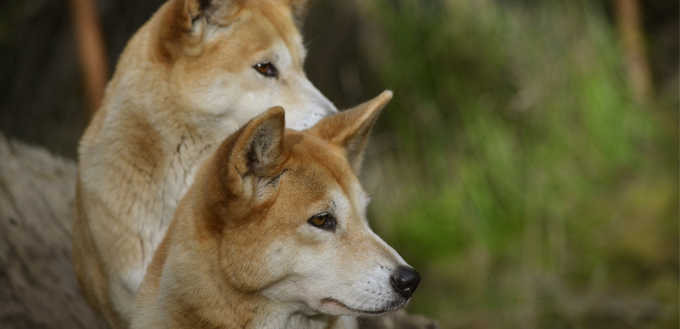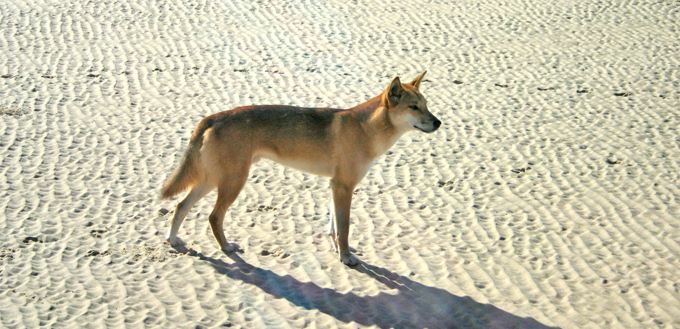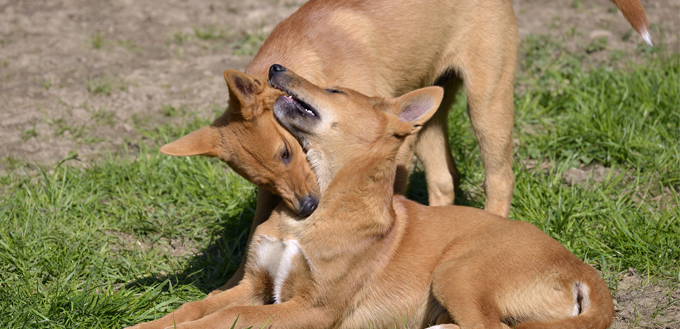Most folks will think that the Carolina Dog (CD) is a crossbreed or, worse, a feral dog that’s a lot similar to the Australian Dingo. And while they may be partially correct owing to the fact that it is only very recently that fanciers of the dog are making significant efforts for standardizing the breed, there is something more to this otherwise ordinary-looking dog. You see, this gentle, devoted, and loyal dog is one of several dog breeds that are largely considered by dog fanciers as ‘primitive’. We’re not saying that it’s an ancient breed (although it is), but rather it has retained much of the dog’s wild, undomesticated nature. But this doesn’t mean it’s not trainable and sociable. It is, but you’ve got to know the tricks of the trade to turn this ‘primitive’ dog into a devoted and gentle family companion.

History of the Carolina Dog
In 1920, American zoologist Glover Morrill Allen described the so-called “Indian dogs” in his article, “Dogs of the American Aborigines”. It is believed that these ‘Indian dogs’ were the Carolina Dogs at the time. Allen suggested that these Indian dogs were the direct descendants of primitive dogs from Asia that were brought to the Americas when man started on his great migration east and west.
However, the ‘rediscovery’ of these free-ranging dogs in the Southeast is generally credited to I. Lehr Brisbin, Jr. who was a senior research ecologist working for the Savannah River Ecology Laboratory of the University of Georgia. Brisbin named these free-ranging dogs as Carolina Dogs because he first came across these dogs while doing field work at the Savannah River Site in South Carolina.
DNA evidence showed that the Carolina Dog can come with one of three general haplotypes which are groups of alleles that these dogs inherited from a single parent. One in twenty Carolina Dogs have ancestral origins in Japanese and Korean dogs. About 58% of Carolina Dogs have universal haplotypes, meaning they share a lot of similarities with many of the dogs found throughout the world. Thirty seven percent of Carolina Dogs carried ancestral haplotypes that were never known or recorded before. Dog DNA analysts say that this sub-haplogroup shows lineage to dogs that have their origins in East Asia.
Using this information, it is safe to say that the Carolina Dog is a descendant of Asian pariah dogs that were brought to the Americas in the prehistoric times, most likely some 7,000 to 20,000 years ago. The general consensus is that these pariah dogs have learned to adapt to the climate and environmental conditions of the American South.
Supporting this fact are the discoveries of mummified remains and skeletons of dogs alongside artifacts that are believed to belong to Indians in the Southwest. Other canine remains were also discovered in the Southeastern forests, typically in ceremonial burials. It is believed that these dogs were the companion animals of Native Americans, lending credence to the idea that the Carolina Dog is an ancient dog.
While it is true that many of these Asian pariah dogs were eventually domesticated, there are still those that are considered to be ‘wild’ or free-range. It is the latter type of pariah dogs that Brisbin encountered while he was working at the Savannah River Site.
In an effort to preserve the ‘primitiveness’ of the Carolina Dog, fanciers are now moving towards its standardization. To date, the dog is already listed in the AKC’s Foundation Stock Service which is regarded as one of the crucial first steps towards the breed’s official full recognition. However, the United Kennel Club already considers the Carolina Dog as an official breed as of 1996 and has published the standards of the breed.
According to the UKC, the Carolina Dog is classified under the organization’s Sighthound and Pariah category. The AKC, meanwhile, has listed the Carolina Dog under the Hound classification while awaiting breed recognition. The American Rare Breed Association has also given due recognition to the Carolina Dog as an official breed, classifying it in Group 5 together with the New Guinea singing dog and the Canaan dog.
Quick Facts
In the past, it was not really easy to distinguish a Carolina Dog from most wild or feral dogs. However, because there are now significant efforts to standardize the breed, it should make identification a lot easier. Here are the facts you need to keep in mind just in case you want to bring this hound into your life.
- The Carolina Dog is also called by other names such as the American Dingo, Yellow Dog, Yeller Dog, Dixie Dingo, Indian’s Dog, North American Native Dog, and Ol’ Yeller.
- This dog can reach heights between 17 and 24 inches, although the AKC puts the foundation standards at 17.75 to 19.5 inches.
- It can weigh between 30 and 44 pounds. The AKC puts a much higher weight limit of 55 lbs, however.
- It can have a life expectancy of 15 years maximum and 12 years minimum.
- The coat can be colored beige, tan, yellow, orange, red sable, or red ginger, although the latter is the preferred color. It comes with pale buff markings usually on the side of the dog’s muzzle as well as on its shoulders. There are paler shadings, too, on the dog’s chest, throat, and underside.
- The coat is short, yet very dense and can have an undercoat.
- Guard hairs are present on the dog’s withers, neck, and back.
- The Carolina Dog has a characteristic “fishhook” tail; this is never loose or slack.
- It has high-set ears that stand up straight on top of its head like a German Shepherd.
- The Carolina has a well-tucked-up belly, well-muscled body, and well-developed chest. Its back is straight and medium in length.
- It comes with an alert expression, albeit its eyes can convey softness and intelligence.

Things You Should Know
Caring for the Carolina shouldn’t be difficult. After all, it has been around for thousands of years. But this doesn’t mean you can go easy on its need for proper socialization and training. If you’re really intent on bringing a Carolina home, then you’ve got to read the following.
Training
The Carolina is an intelligent canine and is quite easy to housebreak. They are one of the very few dogs that are as fastidious as cats. Potty training the Carolina should be a breeze. However, it is important to consider training this dog for obedience and agility since it has tremendous amounts of energy inside its small yet compact body. For the dog, training is work. It gives it a sense of purpose, a meaning in its existence. This is important since you don’t want the Carolina to think that you are neglecting its fundamental needs.
While training the Carolina can be easy, it is best facilitated using positive reinforcement techniques. Giving rewards to reinforce desirable behaviors should help teach the dog to keep on doing that behavior or action which immediately preceded the reward. It’s a cause-effect kind of thing. The Carolina can easily pick this up since it’s an intelligent hound. It is critical that you be the pack leader; not the other way around.
Feeding
A healthy 40-lb Carolina requires 1000 calories to 1100 calories each day. However, this is for a dog that has average activity levels. If it is highly active, then its calorie requirements can be increased. If you want to turn it into a lap dog, then you need to reduce its calorie intake. Be mindful of what you give since some dogs are quite prone to becoming overweight.
The Carolina requires high-quality dog food. If you can provide it with safe and high-quality raw food this would be best since it closely resembles what they eat in the wild. If you have to go for commercially-available dog food, steer away from those that contain a lot of fillers like corn, soy, and wheat. Also stay away from dog food that puts byproduct meals or even carbohydrates as its first ingredient. Your dog needs high-quality animal proteins and healthy fats. It’s perfectly alright to give fruits and veggies as long as it doesn’t take up the bulk of their diet.
Exercise
Carolinas have high energy levels that they require more constructive or positive outlets with which to divert this energy. If not, then you’ll have to prepare yourself for a number of frustrating dog bad behaviors such as nuisance barking, chewing, digging, jumping on and over structures they’re not supposed to, and even shredding everything and anything they can latch their teeth on.
This dog is a hunter. As such it is important that it be given plenty of activities to help it while its time as well as take care of its muscles and joints. It loves chasing a ball that has been rolled on the floor. You can also play hide-and-seek with it. Taking it for its everyday walk is crucial to maintaining its healthy body and well-balanced disposition.
Related Post: Toy Balls for Dogs
Socialization
The Carolina is a formidable hunter, yet it has a gentler nature than other canine hunters out there. It gets along fine with other pets in the household especially if it grew up with them. Socializing the Carolina should be done at a young age. It needs to be introduced to as many different types of people and animals as possible so that it gets the idea that there are other beings in this world and that they are not necessarily prey.
Daily trips to the dog park or any other areas where people and dogs converge or get together is always a good way to socialize the Carolina. Inviting like-minded folks into your home can also help.
Grooming
Grooming the Carolina is pretty easy since it has a relatively short, albeit thick coat. Plus, it takes care of its own grooming needs. It will require weekly brushing, however, so that the oils on its skin will be evenly distributed. During seasonal shedding, more frequent brushing may be needed unless you don’t mind having your home covered in fur.
Related Post: Dog Shedding Brush
Monthly trimming of its nails is important while the brushing of its teeth and cleaning of its gums should be done on a daily basis. If this is not possible, at least twice a week should be okay. The ears should also be inspected and cleaned regularly, preferably every week.
You May Also Like: Dog Nail Clippers and Dog Ear Cleaners
Health
This is one of the sturdiest breeds in the dog world. They have less risk for the development of genetic conditions such as hip dysplasia and progressive retinal atrophy that are commonly seen in domesticated dogs. However, they are still susceptible to other dog conditions such as parasitic infections, allergies, and skin problems.
The Carolina Dog is generally recommended for the following.
- Physically active singles and families
- Outdoorsy folks
- Families with kids not younger than 8 years
- People who know how to train and socialize dogs
- Individuals who are not new to dog ownership
We cannot recommend the Carolina for folks who…
- Are lazy heads and couch potatoes
- Don’t have a spacious backyard
- Don’t like socializing and training hounds

Temperament
Intelligent and resourceful, the Carolina Dog has been around for thousands of years. And while there are questions as to its origins, it can never be denied that it is one of the most resilient dogs around. When properly socialized and trained, it can be a very loyal and affectionate hound. They are usually shy at first. But once they realize that the human family is now their pack, they will instantly show their fierce devotion and loyalty. It can be especially fond with kids, but should never be allowed to play alone with smaller children as its high energy can be risky for tots. Being a hunter at heart, it is still especially reserved towards strangers. Although it is never aggressive towards other animals, it can voice its displeasure.
It may not be as popular as a Labrador, a GSD, or the other breeds of dogs on the planet, but there are plenty of reasons why the Carolina is worthy of being a top dog. Having survived thousands of years surely counts for something.






This article is great. I believe I may have adopted one of these sweet baby’s. She was listed as yellow lab/shepard cross. But has seemed to top out at growing at about 14lbs and not very big not shep/lab size that’s for sure. After much reading I am wanting to do a DNA test on my sweet girl. its amazing reading going oh that’s my baby girl. Reading and learning about this breed has been fun for my son and myself. Looking forward to learning more about our girl.
We have a beautiful female Carolina this article is spot on. Knowing the loving, affection. Bright playful nurturing side if these Gorgeous pups is having one. They are funny, bright, enjoy interaction they are communicators and will communicate their needs..Absolutely a joy and have well earned their TOP SPOT AMONG ALL BREEDS eager to learn interact communicate and will be your forever friend. Amazing companions and very funny
We have a Australian shepherd/Carolina puppy. He’s full of energy. One thing he likes to nip and jump up on us. We have lots of room for him to run and play. We also have a 15 yr old lab/cataholie/Australian shepherd. She is so ezay to train.any advise to get a new training for the puppy Cooper.
Thank you for this information. Thank you very much!
I have a Carolina dog as my service dog. She takes to training great. On the agility course everyone is amazed as high she jumps.
When she runs she leaps like a deer and is unbelievable fast
She is also so loveable to me and my grandchildren
I have a Carolina mix breed. Shorty is the most loyal and loving dog I’ve ever had. You would think he is full blood except for his short front legs.